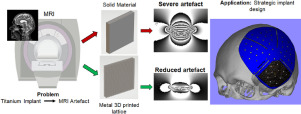当前位置:
X-MOL 学术
›
Acta Biomater.
›
论文详情
Our official English website, www.x-mol.net, welcomes your
feedback! (Note: you will need to create a separate account there.)
Reducing MRI susceptibility artefacts in implants using additively manufactured porous Ti-6Al-4V structures.
Acta Biomaterialia ( IF 9.4 ) Pub Date : 2020-02-28 , DOI: 10.1016/j.actbio.2020.02.038 Luke N Carter 1 , Owen Addison 2 , Nashwan Naji 3 , Peter Seres 3 , Alan H Wilman 3 , Duncan E T Shepherd 4 , Liam Grover 1 , Sophie Cox 1
Acta Biomaterialia ( IF 9.4 ) Pub Date : 2020-02-28 , DOI: 10.1016/j.actbio.2020.02.038 Luke N Carter 1 , Owen Addison 2 , Nashwan Naji 3 , Peter Seres 3 , Alan H Wilman 3 , Duncan E T Shepherd 4 , Liam Grover 1 , Sophie Cox 1
Affiliation

|
Magnetic Resonance Imaging (MRI) is critical in diagnosing post-operative complications following implant surgery and imaging anatomy adjacent to implants. Increasing field strengths and use of gradient-echo sequences have highlighted difficulties from susceptibility artefacts in scan data. Artefacts manifest around metal implants, including those made from titanium alloys, making detection of complications (e.g. bleeding, infection) difficult and hindering imaging of surrounding structures such as the brain or inner ear. Existing research focusses on post-processing and unorthodox scan sequences to better capture data around these devices. This study proposes a complementary up-stream design approach using lightweight structures produced via additive manufacturing (AM). Strategic implant mass reduction presents a potential tool in managing artefacts. Uniform specimens of Ti-6Al-4V structures, including lattices, were produced using the AM process, selective laser melting, with various unit cell designs and relative densities (3.1%-96.7%). Samples, submerged in water, were imaged in a 3T MRI system using clinically relevant sequences. Artefacts were quantified by image analysis revealing a strong linear relationship (RR2 = 0.99) between severity and relative sample density. Likewise, distortion due to slice selection errors showed a squared relationship (RR2 = 0.92) with sample density. Unique artefact features were identified surrounding honeycomb samples suggesting a complex relationship exists for larger unit cells. To demonstrate clinical utility, a honeycomb design was applied to a representative cranioplasty. Analysis revealed 10% artefact reduction compared to traditional solid material illustrating the feasibility of this approach. This study provides a basis to strategically design implants to reduce MRI artefacts and improve post-operative diagnosis capability. STATEMENT OF SIGNIFICANCE: MRI susceptibility artefacts surrounding metal implants present a clinical challenge for the diagnosis of post-operative complications relating to the implant itself or underlying anatomy. In this study for the first time we demonstrate that additive manufacturing may be exploited to create lattice structures that predictably reduce MRI image artefact severity surrounding titanium alloy implants. Specifically, a direct correlation of artefact severity, both total signal loss and distortion, with the relative material density of these functionalised materials has been demonstrated within clinically relevant MRI sequences. This approach opens the door for strategic implant design, utilising this structurally functionalised material, that may improve post-operative patient outcomes and compliments existing efforts in this area which focus on data acquisition and post-processing methods.
中文翻译:

使用增材制造的多孔Ti-6Al-4V结构减少植入物中的MRI敏感性伪像。
磁共振成像(MRI)在诊断植入物手术后的术后并发症以及对邻近植入物的解剖结构进行成像方面至关重要。场强的增加和梯度回波序列的使用突出了来自扫描数据中的磁化伪影的困难。在金属植入物(包括钛合金制成的金属植入物)周围会出现伪影,这使得难以检测并发症(例如出血,感染),并阻碍了周围结构(如大脑或内耳)的成像。现有研究集中于后处理和非常规扫描序列,以更好地捕获这些设备周围的数据。这项研究提出了一种互补的上游设计方法,该方法使用通过增材制造(AM)生产的轻型结构。减少战略性植入物质量是管理人工制品的潜在工具。使用AM工艺,选择性激光熔化,各种晶胞设计和相对密度(3.1%-96.7%),生产出包括晶格在内的Ti-6Al-4V结构均匀的标本。使用临床相关序列,将浸没在水中的样品在3T MRI系统中成像。通过图像分析对伪像进行量化,显示出严重程度与相对样本密度之间存在很强的线性关系(RR2 = 0.99)。同样,由于切片选择错误导致的失真与样本密度之间呈平方关系(RR2 = 0.92)。在蜂窝样品周围发现了独特的伪像特征,表明较大的晶胞存在复杂的关系。为了证明其临床实用性,蜂窝设计应用于代表性颅骨成形术。分析表明,与传统的固态材料相比,伪影减少了10%,这说明了这种方法的可行性。该研究为战略设计植入物以减少MRI伪像并提高术后诊断能力提供了基础。意义声明:金属植入物周围的MRI敏感性伪像为诊断与植入物本身或基础解剖结构有关的术后并发症提出了临床挑战。在本研究中,我们首次证明可以利用增材制造来创建晶格结构,从而可预期地降低钛合金植入物周围的MRI图像伪影的严重程度。具体而言,伪像严重性(总信号丢失和失真)的直接相关性,这些功能化材料的相对材料密度已经在临床相关的MRI序列中得到证实。这种方法利用这种结构功能化的材料为战略性植入物设计打开了大门,这可能会改善患者的术后效果,并补充该领域现有的工作,这些工作侧重于数据采集和后处理方法。
更新日期:2020-02-28
中文翻译:

使用增材制造的多孔Ti-6Al-4V结构减少植入物中的MRI敏感性伪像。
磁共振成像(MRI)在诊断植入物手术后的术后并发症以及对邻近植入物的解剖结构进行成像方面至关重要。场强的增加和梯度回波序列的使用突出了来自扫描数据中的磁化伪影的困难。在金属植入物(包括钛合金制成的金属植入物)周围会出现伪影,这使得难以检测并发症(例如出血,感染),并阻碍了周围结构(如大脑或内耳)的成像。现有研究集中于后处理和非常规扫描序列,以更好地捕获这些设备周围的数据。这项研究提出了一种互补的上游设计方法,该方法使用通过增材制造(AM)生产的轻型结构。减少战略性植入物质量是管理人工制品的潜在工具。使用AM工艺,选择性激光熔化,各种晶胞设计和相对密度(3.1%-96.7%),生产出包括晶格在内的Ti-6Al-4V结构均匀的标本。使用临床相关序列,将浸没在水中的样品在3T MRI系统中成像。通过图像分析对伪像进行量化,显示出严重程度与相对样本密度之间存在很强的线性关系(RR2 = 0.99)。同样,由于切片选择错误导致的失真与样本密度之间呈平方关系(RR2 = 0.92)。在蜂窝样品周围发现了独特的伪像特征,表明较大的晶胞存在复杂的关系。为了证明其临床实用性,蜂窝设计应用于代表性颅骨成形术。分析表明,与传统的固态材料相比,伪影减少了10%,这说明了这种方法的可行性。该研究为战略设计植入物以减少MRI伪像并提高术后诊断能力提供了基础。意义声明:金属植入物周围的MRI敏感性伪像为诊断与植入物本身或基础解剖结构有关的术后并发症提出了临床挑战。在本研究中,我们首次证明可以利用增材制造来创建晶格结构,从而可预期地降低钛合金植入物周围的MRI图像伪影的严重程度。具体而言,伪像严重性(总信号丢失和失真)的直接相关性,这些功能化材料的相对材料密度已经在临床相关的MRI序列中得到证实。这种方法利用这种结构功能化的材料为战略性植入物设计打开了大门,这可能会改善患者的术后效果,并补充该领域现有的工作,这些工作侧重于数据采集和后处理方法。











































 京公网安备 11010802027423号
京公网安备 11010802027423号